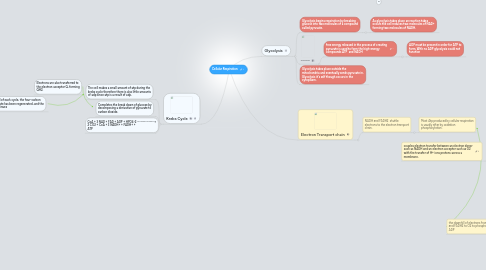Cellular Respiration
by Michael Reed


1. Krebs Cycle
1.1. The cell makes a small amount of atp during the krebs cycle therefore there is also little amounts of adp since atp is a result of adp.
1.2. Completes the break down of glucose by decomposing a derivative of pyruvate to carbon dioxide.
1.3. CoA + 3 NAD + FAD + ADP + HPO4-2 ---------------> 2 CO2 + CoA + 3 NADH+ + FADH+ + ATP
2. Takes place in the mitochondrion
3. Electrons are also transferred to the electron acceptor Q, forming QH2.
4. At the end of each cycle, the four-carbon oxaloacetate has been regenerated, and the cycle continues
5. couples electron transfer between an electron donor such as NADH and an electron acceptor such as O2 with the transfer of H+ ions protons across a membrane.
5.1. The electron transport chain also takes in the mitochondrion.
6. h
7. Glycolysis
7.1. Glycolysis begins respiration by breaking glucose into two molecules of a compound called pyruvate.
7.1.1. As glycolysis takes place an reaction takes occurs the cell reduces two molecules of NAD+ forming two molecules of NADH.
7.2. Glycolysis
7.2.1. free energy released in the process of creating pyruvate is used to form the high-energy compounds ATP and NADH
7.2.1.1. ADP must be present in order for ATP to form. With no ADP glycolysis could not function
7.3. Glycolysis takes place outside the mitochondria and eventually sends pyruvate in. Glycolysis it's self though occurs in the cytoplasm.
8. Electron Transport chain
8.1. NADH and FADH2 shuttle electrons to the electron transport chain.
8.1.1. Most Atp produced by cellular respiration is usually after by oxidation phosphorylation.
